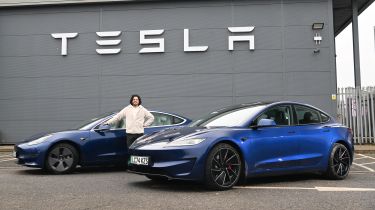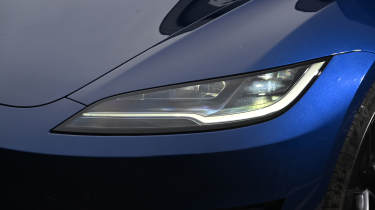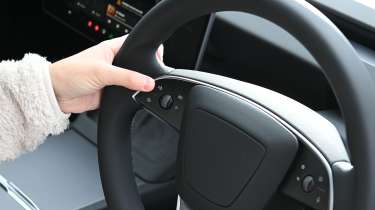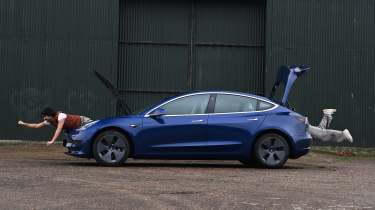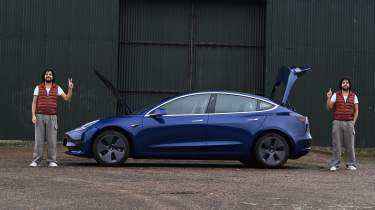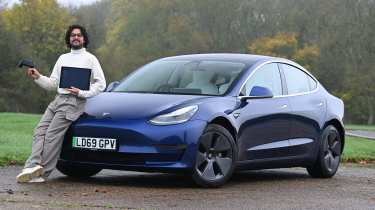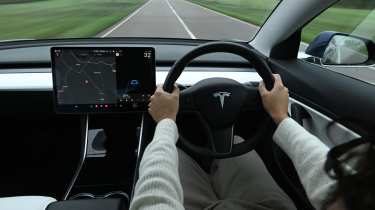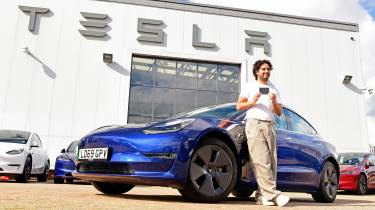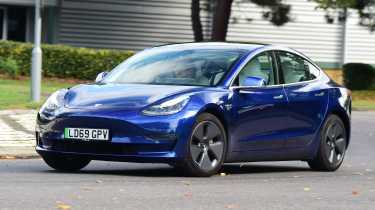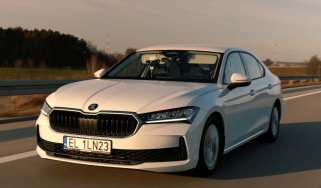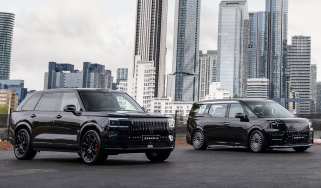Used Tesla Model 3 Dual Motor long-term test: popular EV meets its replacement
Final report: we compare used with new as we say goodbye to our EV

Verdict
There are lots of used electric cars that offer value for money and the Tesla Model 3 is one of them. It packs serious performance, is practical and still feels modern. Long-term build quality is questionable, and efficiency in cold weather is compromised, but this is offset by the vast Supercharger network.
- Mileage: 67,141
- Efficiency: 3.4mi/kWh
Six months have passed since this 2019 Tesla Model 3 arrived on the Auto Express fleet, to find out how a six-year-old version has aged, and if it’s still cutting edge.
The early Dual Motor Performance was a worthy companion overall, and left us with a good idea of how early Model 3s might feel now there are several on the used market.
To further our sense of how the car has evolved, we hunted down the equivalent top-spec Performance variant today, even to the point of finding one with the same Deep Blue Metallic paint finish, to compare them.
First, the positives... starting off with the powertrain, which is brilliant on both. Tesla knows how to calibrate EVs like few other makers, with a consistency and feel to the throttle and brakes, which makes driving much easier and more intuitive than in rivals.
Used - available now

2021 Tesla
Model 3
86,710 milesAutomaticElectric
Cash £13,333
2021 Tesla
Model 3
16,590 milesAutomaticElectric
Cash £17,799
2021 Tesla
Model 3
47,894 milesAutomaticElectric
Cash £15,465
2023 Tesla
Model 3
22,550 milesAutomaticElectric
Cash £21,797The new Model 3 Performance hasn’t picked up much more poke. In fact, the latest version produces 460bhp, only around 10bhp more than our 2019 model, so performance is pretty much unchanged. But the good news is that many of the clever software tricks, such as a configurable Track Mode, have all been implemented on older models via over-the-air updates. This includes the ability to vary stability and traction systems, and control torque split. Granted, most owners won’t often delve into such toys, but for a ‘Performance’ model, they’re nice to have.
What has changed is the chassis. Our Tesla isn’t sophisticated to drive, with a firm ride, and despite running on conservative 18-inch wheels, a tendency to crash into potholes.
Drive the new car in isolation and you could be mistaken for thinking it’s much the same, but tested back-to-back the impact of its revisions becomes clear. The adaptive suspension feels finely tuned, giving a more controlled – if not more comfortable – ride and a useful increase in body control.
The brakes feel more powerful – essential when you have so much performance – but are more resilient, which is reassuring. After a spirited drive, our car often saw the pedal reach the floor. The new Performance model’s wheels, unique front end and revised seats definitely make it feel more sporty. Also impressive on both are their digital interfaces. The 15.4-inch screen and its software are unrivalled in ease of use and intuitive layout.
While some aspects, such as changing the mirror positions or opening the glovebox, are better served with physical controls, with time even the most technophobic of drivers will have no problem adapting to a more digital driving experience.
Tesla’s Supercharger network is another major plus. It offers fast charging and reasonable rates, and they’re easy to find on major commuting routes. This is in addition to the UK’s wider charging network, which is constantly being expanded. The fact it’s no more difficult than plugging in and letting it do its thing is another tick for the user experience. So if regular charging on the go is essential to your EV ownership experience, this is not to be underestimated.
Here’s where the ‘buts’ come in, though. The interior has aged well, but the overall quality isn’t great. Creaks and rattles have appeared, so I’m grateful that the excellent sound system can drown them out.
Our early model has no heat pump and was dropping charge overnight in the cold. While this is rectified in the new car, low temperature is still an enemy of EVs unless you plan ahead.
We also mentioned in a previous update that the doors can refuse to unlatch in icy weather; it’s true that pre-warming the cabin is a useful way around it, but we have since been told by a reader that you’re able to open the door via the app – a useful piece of advice.
In essence, the new Model 3 Performance is a superior car to the previous one, and while Tesla’s not following the norm with a traditional seven-year life-cycle, there’s a reason for people who own a Model 3 like ours to step up to a new-generation car.
Those hoping for a wholesale change will be disappointed, though, and how long the Tesla will stay near the top of the class when BMW’s new-era Neue Klasse, Mercedes’ all-new C-Class and Audi’s fresh A4 E-Tron all arrive in the next 24 months remains to be seen.
But there’s a problem for Model 3s, and all Teslas, that sits outside of the actual car and its pros and cons. From a personal perspective, some close family members were looking at buying a £20,000 EV. When the Model 3 arrived, they had a poke around and felt it might be a great option, a notion that I wholeheartedly approved of. However, much has changed in six months and, quite simply, a Tesla is no longer on their shopping list – nor would it be on mine.
Used Tesla Model 3 Dual Motor: our Tesla offers loads of space, but other aspects are less impressive
- Mileage: 65,912
- Efficiency: 3.4mi/kWh
If there’s one genuine, inarguable benefit to electric cars, it would have to be the advancements in vehicle packaging made possible with an electric powertrain. Our Model 3 is very cleverly designed, so while its on-paper boot capacity of 425 litres might not seem particularly huge by class standards, this figure doesn’t take into account its true practicality.
To begin with, there’s considerable under-floor storage in the boot that can swallow all sorts of odds and ends. The raised floor then creates a flat loadbay when the second-row seats are folded, and there are some added little cubbies on either side; these make a great place to stash shopping bags.
This is supplemented by the ‘frunk’, which adds a further 144 litres, bringing the total up to 569 litres. This separate load space is a perfect place to store a mucky charge cable, rather than in the main boot or the storage space underneath it.
There are even more compartments to be found inside the cabin, too, and the centre console is simply massive. There’s an area under the phone rest that’s large enough for a handbag or a tote bag.
Yet life hasn’t all been rosy with our Model 3 as temperatures drop and we trudge through the UK winter. The range regularly suffers when it’s less than 10 degrees Celsius, and we often find that no more than about 150 miles are possible from the 80 per cent that we generally top up to when Supercharging.
Even more irksome is the loss of up to five to six per cent of the car’s range when parked up in the cold overnight. This makes it tricky to plan ahead when you’re stretching your available range to reach that next charge point. While it’s not unusual to see efficiency drops in winter, the Tesla seems particularly affected when parked, rather than while being driven.
The cold is having some other rather detrimental effects, too. The flip-out door handles and frameless doors might look slick, but unless the car has been preheated before you go out to it in the morning, an overnight cold snap can cause all those bits to freeze up and, in effect, lock you out of the car.
On top of that, when deputy editor Richard Ingram took brief custody of the Model 3, he noted that once the car was up and running, one of the rear windows refused to go back up after popping down when the door opened.
Indeed, question marks over the Tesla’s build quality are also starting to mount, with more squeaks, rattles and creaks being added seemingly by the day. An example of this is that some of the door-handle mechanisms are a little slow to return to the closed position, meaning that when you shut the door, the latch is sometimes still open, with the result that the door just bounces open again.
Finally a note to all those motorists who think Model 3 owners drive with their full beam on at all times: this is unfortunately a systematic technical issue across early versions due to poorly calibrated dipped beam. It’s also not helped by a slow-reacting automatic full-beam function.
Used Tesla Model 3 Dual Motor: second fleetwatch
The Model 3’s in-car games mean owners will rarely be bored while waiting for the EV to charge
I remember playing one of the Tesla Model 3’s touchscreen-based games when the brand first brought the model to market in 2019 and being only marginally impressed. But things have moved on considerably in six years; there are now loads more options than just a Mariokart-style driving game. It certainly takes the boredom out of any charging stops – those high scores are there to be broken!
Used Tesla Model 3 Dual Motor: second report
We’re getting to grips with the screen that controls everything
- Mileage: 64,825
- Efficiency: 3.9mi/kWh
It's not unheard of for car makers to try to identify as a tech companies, but if there’s one that actually fits the bill, it would probably be Tesla.
Since the first Model S, it has been doing everything differently, and while there are some elements of a modern Tesla that seem initially challenging, we’ve found that when it comes to the user interface, the American brand is really on to something.
In the past, when driving a Tesla for short periods, it was difficult to wrap our heads around the quirks of the system. But after a longer stint in our Model 3, I have to say that a lot of it just makes plain good sense – and that’s coming from a fierce supporter of the traditional knob or button.
Obviously, the main interface within a Tesla Model 3’s interior is the touchscreen, which we still think is one of the best in the business. Our car, remember, is now around five years old and yet it doesn’t feel even remotely out of date. In fact, it’s still very much a leader in the segment.
To start with, simple tasks such as listening to music or changing the temperature on the climate control are easy and accessible from the main screen. If you want more detail, you press that section of the screen and new options will open up in a floating window.
As an avid listener to Apple Music, I don’t need to use my phone and connect it through the system. That means the app is embedded into the interface, and with my login connected, all the music and playlists on my other devices are available in the car. The same goes for Spotify, or podcast apps.
There’s been lots of controversy about elements such as the adjustment controls for the door mirrors and steering column being controlled through the screen, but in actual fact this isn’t really an issue.
Once chosen, the left-hand steering wheel roller controls change function to adjust either the mirrors or steering column, and work brilliantly. Their functions extend even further, because a tap of the left stalk opens up a menu for the wipers. Activate cruise control and the one on the right can tweak the distance to the car ahead with a left or right push, and the speed with the roller.
Once any of these settings have been changed, you shouldn’t ever need to alter them. As in some new cars, the Model 3 has specific driver profiles stored, which means that if you select the right person, all adjustable elements controlled through the screen are set for them. And if you change them on the move, you’re given an option to save them or not. Very clever.
With some familiarisation, then, all the Tesla’s touchpoints become second nature, feeling closer to the iPads and PlayStation controllers that we’ve been using over the past couple of decades than anything as clumsy as a small car touchscreen.
Used Tesla Model 3 Dual Motor: first fleetwatch
Superb Supercharger network boosts popular EV’s appeal even further
We’ve been taking advantage of Tesla’s Supercharger network. Despite often not quite reaching the incredible speeds some chargers are capable of, its ease, availability and reliability take away all the stress of charging on the go. It’s also relatively affordable, with prices variable depending on the day, but generally costing just over half that of an equivalently powerful charger. So far the best thing about having a Tesla has nothing to do with the car at all.
Used Tesla Model 3 Dual Motor: first report
A 2019 version of Tesla’s best-seller joins our fleet - but how is it holding up?
- Mileage: 63,400
- Efficiency: TBC
How times change. It feels like only yesterday that people were climbing over barbed wire fences to get a hold of an electric car. But now, not only are waiting times coming down, but there’s also a knock-on effect of lowering prices in the rapidly growing used electric car market.
With this in mind, the question of whether it’s a good idea to take the plunge on a second-hand example is becoming more relevant. But how can we find out? Well, as one of the biggest-selling EV brands in Europe over the last few years, Tesla is a great place to start, and with its Certified Pre-Owned (CPO) vehicle service now operational, it’s a chance for us to see what sort of service the firm offers.
Our 69-plate Model 3 will be with us for the next few months and over that time we’ll be answering the series of questions that you, and we, have been asking. This includes how build quality has held up and how well the battery and motors have lasted.
Our example is a 2019 car with the top-spec high-output motors, but is not an official ‘Performance’ model, so doesn’t feature its chassis tweaks or bigger brakes. The only visual cue that our car is packing serious power is a red line under the dual-motor badge. Even its wheels are the basic 18-inch aero-spec rims found on the standard car.
It has done some 63,000 miles, and comes with an ambitiously bright white interior. Yet on first glance, everything looks surprisingly good in terms of wear and tear. Of course, this may well have something to do with the fact that all of Tesla’s CPO models undergo a comprehensive checkover and refurbishment before reaching a new customer.
To get a sense of what this entails, we were shown around one of Tesla’s CPO centres and ran through the process leading up to handover. The operation starts by selecting the car itself: it has to have less than 90,000 miles and be in good condition.
Small bumps and scrapes are fine – these can be tidied in-house – but cars with any more than that won’t be accepted in the scheme, ensuring that a sales vehicle is up to standard and has no major damage. It also comes with an additional one-year or 10,000-mile warranty from the date of delivery, if it’s outside the four-year, 50,000-mile factory cover. Battery and drive units are covered for eight years or 150,000 miles, both of which are over the statutes for CPO vehicles.
Our car does have the usual stone chips, scratches and blemishes you’d expect of any five-year-old model with over 60,000 miles, but is in good order inside and has aged well. The minimalist interior means there’s very little in the cabin that looks or feels worn. Even the gloss centre console is blemish-free.
There are other advantages to running a Tesla as a second-hand buy, and that’s got a lot to do with how the car was designed from the outset to adopt over-the-air updates. This also means that, where fitted, most of the latest autonomous driving functions are in play, such as Tesla’s Autopilot system. We also have full access to the Tesla app, which gives us a virtual key via the iPhone app, plus the ability to pre-plan trips and pre-condition the cabin – we’re particularly looking forward to that one as winter nights draw in.
There’s a final bonus in our pre-2023 car compared to newer versions, too, in that it has a traditional set of indicator stalks and a gear selector – unlike the latest Model 3. Arguably, though, the best part of owning a Tesla is access to the Supercharger network, which continues to be the best in the business in terms of charging rate, cost and ease of use.
On the road, first impressions are good. The ride is firm and the steering a bit short on feel, but the car remains incredibly powerful after 63,000 miles, with an immense turn of speed.
For the £21,500 value of our Model 3, you could instead find yourself in a slightly older BMW 340i or an Audi S4 with similar mileage, less performance and probably much higher running costs. But the question is, do either of those feel quite as modern as the Model 3?
There’s only one way to find out. And over the next few months, as we live with ours, we’ll be able to tell you for definite whether a used Tesla is likely to be the biggest boom – or bust – in the used-car market.
| Rating: | 4 stars |
| Model: | Tesla Model 3 Dual Motor |
| On fleet since: | August 2024 |
| Price new: | £56,490 |
| Price now: | £21,500 |
| Powertrain: | 75kWh battery, 2x e-motor, 444bhp |
| CO2/BiK: | 0g/km/2% |
| Options: | None |
| Insurance: | Group: 50/Quote: £713 |
| Mileage: | 67,141 |
| Any problems? | Creaky trim, frozen doors, battery drains in cold weather |

